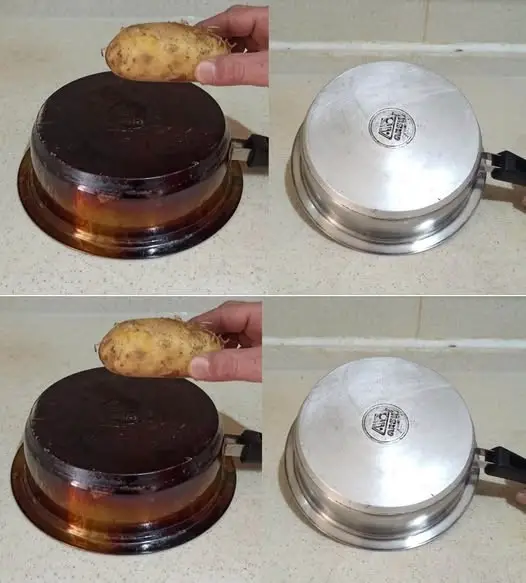We’ve all been there — you step away from the stove for just a minute, and suddenly the bottom of your pot is scorched. Whether it’s rice, pasta, or soup, burnt-on food can leave your cookware looking hopeless. Most people toss the pot or resign themselves to hours of soaking and scrubbing. But don’t rush to throw it away — there’s an incredibly simple trick that can make even the worst burnt pot look almost brand new.
This method doesn’t require harsh chemicals or expensive cleaners. In fact, you probably already have everything you need right in your kitchen.
Here’s how to rescue that scorched pot — and why it works.
Why Pots Get Burnt (And Why It’s So Hard to Clean)
Burnt pots usually result from overheating, using too little liquid, or getting distracted while cooking. Once the food at the bottom of the pan starts burning, it creates a thick, black crust that clings stubbornly to the metal.
What makes this residue especially difficult is that it’s carbonized food — essentially charcoal stuck to your pan. Regular dish soap won’t cut it, and aggressive scrubbing can ruin your cookware’s finish.
So what’s the solution?
The Surprising Burnt Pot Hack You Need to Try
Instead of scrubbing endlessly, try this simple and effective cleaning trick:
You’ll Need:
- 1 cup of white vinegar
- 2 tablespoons of baking soda
- 1–2 cups of water
- A soft sponge or wooden spatula
Step-by-Step Instructions:
Step 1: Fill the Pot with Water and Vinegar
Pour enough water into the burnt pot to cover the blackened area. Add about one cup of vinegar. Turn on the stove and bring the mixture to a boil. Let it simmer for a few minutes.
“Boiling vinegar helps loosen stubborn burnt bits and neutralizes odors,” say cleaning experts.
The heat helps soften the charred residue, while the vinegar starts to break it down chemically.
Step 2: Remove from Heat and Add Baking Soda
Turn off the heat and slowly add two tablespoons of baking soda. The reaction between vinegar and baking soda will create fizz — this is normal.
“The bubbling action helps lift the grime off the surface,” explains one home cleaning specialist.
Let the mixture sit for about 15–20 minutes.
Step 3: Scrub Gently
After the fizzing stops and the pan has cooled slightly, use a soft sponge or a wooden spatula to gently scrape off the burnt bits. You’ll notice that much of the residue comes off with very little effort.
If needed, repeat the process once more for especially stubborn stains.
Step 4: Rinse and Wash Normally
Once clean, wash the pot with warm soapy water and rinse thoroughly. Dry it off, and your pan will look nearly as good as new.
Why This Hack Works So Well
This method combines heat, acid, and a mild abrasive — the holy trinity of non-toxic cleaning:
- Vinegar breaks down burnt-on food and neutralizes odors.
- Baking soda acts as a mild abrasive to lift off debris without damaging your pot.
- Boiling water loosens the stuck-on layers, making it easier to wipe them away.
Together, they form a chemical reaction that’s both safe and powerful.
Alternative Methods for Burnt Pot Cleanup
If you’re out of vinegar or baking soda, here are a few backup tricks:
1. Salt and Lemon Scrub
Sprinkle coarse salt onto the burnt area, then rub it with half a lemon. The salt scrubs gently while the lemon juice helps break down residue. Best for light burns or discoloration.
2. Dryer Sheet Soak
Fill the pot with warm water and toss in a dryer sheet. Let it soak for a few hours or overnight. The anti-static agents help loosen burnt food particles.
“This method is surprisingly effective on medium scorched layers,” some users say.
3. Commercial Pot Cleaners
Bar Keepers Friend, Bon Ami, and similar products can work wonders, especially for stainless steel. Always follow the manufacturer’s directions and test a small area first.
Avoid These Common Mistakes
When cleaning a burnt pot, don’t make the problem worse. Avoid:
- Steel wool or metal scouring pads – These can scratch and ruin non-stick or stainless finishes.
- Bleach or harsh chemicals – Not only are they overkill, but they can react badly with metal.
- Throwing it away too soon – Most burnt pots are salvageable with a little patience.
How to Prevent Burnt Pots in the Future
Prevention is the best medicine. Here’s how to avoid burning your pots in the first place:
- Always use enough liquid when cooking grains or pasta.
- Stir frequently, especially with thick or starchy dishes.
- Use low to medium heat — high heat increases the risk of scorching.
- Invest in heavy-bottomed pans, which distribute heat more evenly.
And perhaps the most obvious one: don’t walk away while something is cooking.
Final Thoughts: Don’t Ditch It — Fix It
A burnt pot doesn’t have to mean a ruined pot. With this simple kitchen chemistry, you can bring scorched pans back to life using items already in your pantry. It’s fast, safe, and satisfying — and best of all, it doesn’t involve hours of elbow grease.
So the next time disaster strikes on the stovetop, remember this trick. You’ll not only save your cookware but avoid waste and expensive replacements. Happy cleaning!

